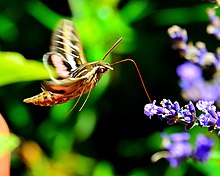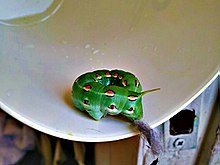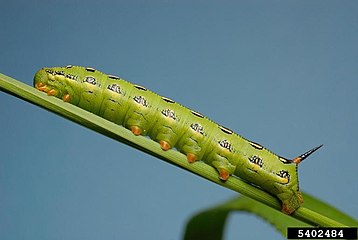
Moths are a group of insects that includes all members of the order Lepidoptera that are not butterflies. They were previously classified as suborder Heterocera, but the group is paraphyletic with respect to butterflies and neither subordinate taxon is used in modern classifications. Moths make up the vast majority of the order. There are approximately 160,000 species of moth, many of which have yet to be described. Most species of moth are nocturnal, although there are also crepuscular and diurnal species.

The hummingbird hawk-moth is a species of hawk moth found across temperate regions of Eurasia. The species is named for its similarity to hummingbirds, as they feed on the nectar of tube-shaped flowers using their long proboscis while hovering in the air; this resemblance is an example of convergent evolution.

The Sphingidae are a family of moths commonly called sphinx moths, also colloquially known as hawk moths, with many of their caterpillars known as "hornworms"; it includes about 1,450 species. It is best represented in the tropics, but species are found in every region. They are moderate to large in size and are distinguished among moths for their agile and sustained flying ability, similar enough to that of hummingbirds as to be reliably mistaken for them. Their narrow wings and streamlined abdomens are adaptations for rapid flight. The family was named by French zoologist Pierre André Latreille in 1802.

The name death's-head hawkmoth refers to any of three moth species of the genus Acherontia. The former species is found throughout Africa and in Europe, the latter two are Asian; most uses of the common name refer to the African species. These moths are easily distinguishable by the vaguely human skull-shaped pattern of markings on the thorax. They are large nocturnal moths with brown and yellow or orange coloring, and all three species are fairly similar in size, coloration and life cycle.

Deilephila elpenor, the elephant hawk moth or large elephant hawk moth, is a moth in the family Sphingidae. Its common name is derived from the caterpillar's resemblance to an elephant's trunk. It is most common in central Europe and is distributed throughout the Palearctic region. It has also been introduced in British Columbia, Canada. Its distinct olive and pink colouring makes it one of the most recognisable moths in its range. However, it is quite easy to confuse the elephant hawk moth with the small elephant hawk moth, a closely related species that also shares the characteristic colours.

Manduca quinquemaculata, the five-spotted hawkmoth, is a brown and gray hawk moth of the family Sphingidae. The caterpillar, often referred to as the tomato hornworm, can be a major pest in gardens; they get their name from a dark projection on their posterior end and their use of tomatoes as host plants. Tomato hornworms are closely related to the tobacco hornworm Manduca sexta. This confusion arises because caterpillars of both species have similar morphologies and feed on the foliage of various plants from the family Solanaceae, so either species can be found on tobacco or tomato leaves. Because of this, the plant on which the caterpillar is found does not indicate its species.
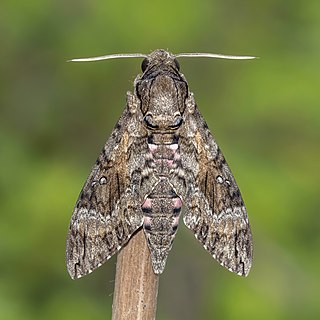
Agrius cingulata, the pink-spotted hawkmoth or sweetpotato hornworm, is a moth in the family Sphingidae. The species was first described by Johan Christian Fabricius in 1775.
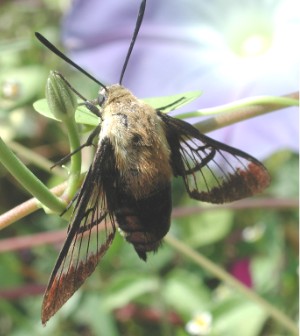
Hemaris is a genus of sphinx moths in the subfamily Macroglossinae, which is native to the Holarctic. Their main host plants are herbs and shrubs of the teasel and honeysuckle families. Moths in genus Hemaris are known collectively as clearwing moths or hummingbird moths in the US and Canada and bee hawk-moths in Britain. The related Old World hummingbird hawk-moths, genus Macroglossum, are similar in appearance and habits. Both genera have tails that are provided with an expansile truncated tuft of hairs, but only Hemaris has the disc of the wings transparent, as these scales are dropped soon after eclosion.
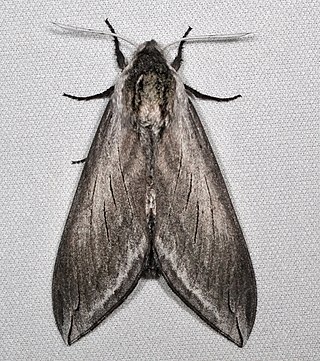
Sphinx perelegans, commonly known as the elegant sphinx, is a species of hawkmoth described by Henry Edwards in 1874. It is a large gray moth native to western North America.

Daphnis nerii, the oleander hawk-moth or army green moth, is a moth of the family Sphingidae. It was described by Carl Linnaeus in his 1758 10th edition of Systema Naturae.

Hyles gallii, the bedstraw hawk-moth or galium sphinx, is a moth of the family Sphingidae. The species was first described by S. A. von Rottemburg in 1775.
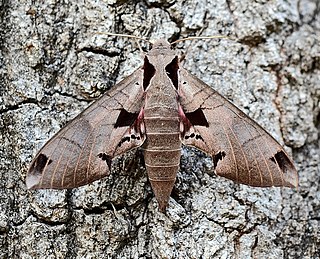
Eumorpha achemon, the Achemon sphinx, is a moth of the family Sphingidae. The species was first described by Dru Drury in 1773.

Hemaris thysbe, the hummingbird clearwing, is a moth of the family Sphingidae (hawkmoths). Coloration varies between individuals, but typically the moth is olive green and burgundy on its back, and white or yellow and burgundy on the underside. Its wings are transparent with a reddish-brown border. It has light-colored legs, which combined with the lack of striping on the underside is diagnostic. Beating its wings rapidly, H. thysbe hovers to collect nectar from a variety of flowers. The combination of its appearance and its behavior commonly leads to it being confused with a hummingbird or bumblebee.

Proserpinus is a genus of moths in the family Sphingidae, the sphinx moths or hawk moths. Species of the genus are native to North America with the exception of P. proserpinus, which has a much larger range extending from Asia to Africa. The genus was erected by Jacob Hübner in 1819.
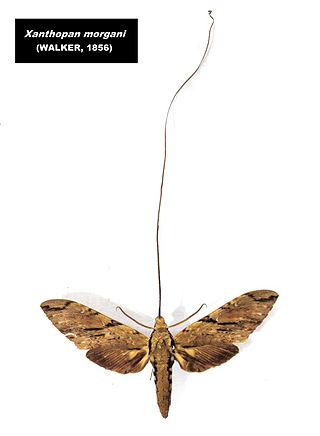
Xanthopan is a monotypic genus of sphinx moth, with Xanthopan morganii, commonly called Morgan's sphinx moth, as its sole species. It is a very large sphinx moth from Southern Africa and Madagascar. Little is known about its biology, though the adults have been found to visit orchids and are one of the main pollinators of several of the Madagascar endemic baobab (Adansonia) species, Adansonia perrieri or Perrier's baobab.

Hyles livornica, the striped hawk-moth, is a moth of the family Sphingidae.

Hyles nicaea, the Mediterranean hawk-moth, is a moth of the family Sphingidae. The species was first described by Leonardo de Prunner in 1798.

Basiothia schenki, the brown striped hawk, is a moth of the family Sphingidae. The species was first described by Heinrich Benno Möschler in 1872. It is known from Zimbabwe and South Africa.

Hyles centralasiae, the eastern foxtail-lily hawkmoth, is a moth of the family Sphingidae. The species was first described by Otto Staudinger in 1887. It is found from eastern Turkey and Armenia east across northern Iraq, northern Iran, southern Turkmenistan, the mountainous areas of eastern Uzbekistan and southern Kazakhstan to Tajikistan, Kyrgyzstan, Afghanistan and northern Xinjiang in China.
